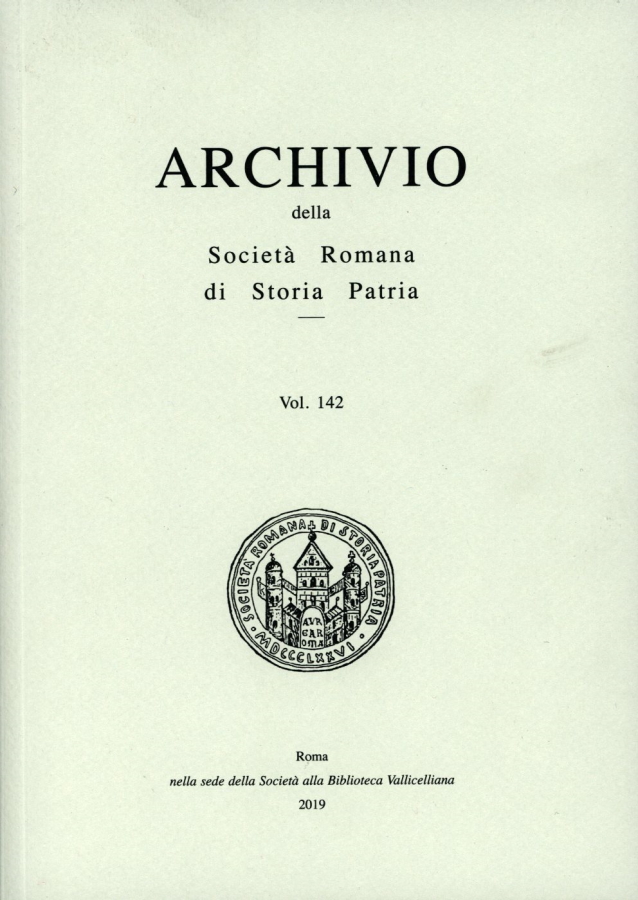Archivio della Società romana di storia patria vol. 142 (2019)
60,00€
INDICE
Paola Guerrini, Testimonianze ottoniane sull’Isola Tiberina. La chiesa di San Bartolomeo all’Isola
Francesca Lembo Fazio, Spoliazioni e interventi di reimpiego a Roma. Testimonianze materiali e indizi della documentazione notarile e degli enti ecclesiastici del XIII e XIV secolo
Andrea Calcagni, Da Cori a Roma. I Guastaferri fra XVI e XVII secolo
Laura Gigli, Lettura e interpretazione della legge picta a Palazzo Baldassini
Luca Irwin Fragale, La massoneria da Roma al Parlamento fascista
Commemorazioni. Armando Petrucci
Attilio Bartoli Langeli, Memorie di Armando
Antonio Ciaralli, Armando Petrucci e Roma
Marco Palma, Armando Petrucci (1932-2018)
Fabio Troncarelli, Il Boezio di Coluccio Salutati
Periodici pervenuti alla Società, a cura di Francesca Pardini
Pubblicazioni pervenute alla Società, a cura di Francesca Pardini
Atti della Società. Consiglio Direttivo (7 gennaio, 14 marzo, 11 luglio, 25 settembre 2019); Assemblea dei Soci (10 gennaio, 14 marzo 2019)
Cariche Sociali
Summaries
Testimonianze ottoniane sull’Isola Tiberina. La chiesa di San Bartolomeo all’Isola
Paola Guerrini
The church of San Bartolomeo all’Isola Tiberina was dedicated by Otto III to Adalbert of Prague. Together with the relics of the bishop and martyr, the church also preserves important testimonies of the Ottonian period: the capitals still visible in the crypt, the wellhead at the center of the nave, a bronze shield on the right wall of the presbytery and the cross placed on top of the bell tower. The essay describes the individual pieces.
Spoliazioni e interventi di reimpiego a Roma. Testimonianze materiali e indizi nella documentazione notarile e degli enti ecclesiastici del XIII e XIV secolo
Francesca Lembo-Fazio
The reuse of ancient materials during the Middle Ages has often been considered as connected to economic and technical issues. However, it is possible to recognize also symbolic motivations behind the appropriation of antiquities, particularly in Rome in the XIII and XIV centuries. Thus, it is necessary to support the direct study of the architectures with the analysis of written sources, selecting both notarial deeds and documents from ecclesiastical archives. In doing so, it is possible to recognise the process of selection and reuse of antiquities, locating the excavation sites and making assumptions on the meaning of ancient materials in different reuse contexts.
Da Cori a Roma. I Guastaferri fra XVI e XVII secolo
Andrea Calcagni
This essay outlines the historical development of the Guastaferri family, from its transfer to Rome in the early 16th century to its extinction in the second half of the 17th century. The Guastaferri family was linked to noble and bourgeois families in Rome. The essay closes with a biographical profile of Fabrizio Guastaferri, an important personality of the Roman scientific environment of the 17th century.
Lettura e interpretazione della legge picta a Palazzo Baldassini
Laura Gigli
This essay identifies the program of the decoration painted by Polidoro da Caravaggio and Maturino da Firenze in the study of the jurist Melchiorre Baldassini, until not yet fully deciphered. The frescos represent the XII tables, the first written codification of norms in the history of Rome, compiled in 451-450 B.C. and considered a source of private and public law. A topic, therefore, on the agenda of the juridical culture of the time which inspired Baldassini for the decoration of his study. The text also investigates the choice of the site for the building of the Palazzo by Antonio da Sangallo.
La massoneria da Roma al parlamento fascista
Luca Irwin Fragale
This essay examines the results of a research dealing with the specific time span referring to a particularly relevant three-year period, namely from the march on Rome until the promulgation of the law which banned associations: within this period the paper examine the co-presence of members of Parliament who were both in charge with legislative power as well as members of the same masonic lodges within the city of Rome. We have thus started with the cross-examination between the lists of names of deputies (appointed during the two legislatures, XXVI and XXVII, enclosing the three-year period) and senators (appointed before and during the above-mentioned legislatures) and those of the members of Freemasonry during the same period.
Archivio
maggio 2021, pp. 300
Disponibile


